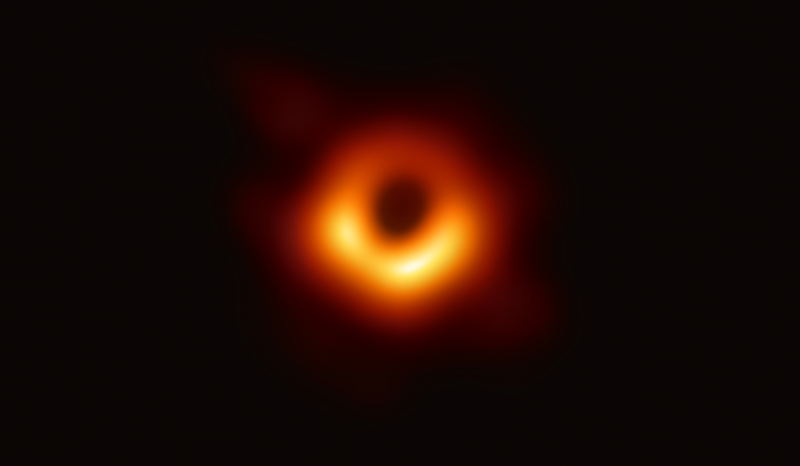
Scientists have obtained the first image of a black hole, using Event Horizon Telescope observations of the center of the galaxy M87. The image shows a bright ring formed as light bends in the intense gravity around a black hole that is 6.5 billion times more massive than the Sun. This long-sought image provides the strongest evidence to date for the existence of supermassive black holes and opens a new window onto the study of black holes, their event horizons, and gravity. Credit: Event Horizon Telescope Collaboration
Humanity’s first glimpse of a black hole, one of the universe’s most dramatic phenomena, a “sinkhole in space-time” itself, was unveiled by scientists at a half-dozen press conferences this morning.
The Event Horizon Telescope project used eight ground-based radio telescopes to produce the image at the center of a massive galaxy 55 million light-years away.
“We have seen what we thought was unseeable,” said Shep Doeleman, a Harvard Senior Research Fellow who is also part of EHT.
The black hole is located in the center of Messier 87, in the Virgo galaxy cluster. The black hole is estimated to have a mass 6.5 billion times that of our sun.
The trick in looking at the black hole, traditionally considered invisible since it lets virtually nothing escape its pull, was through finding the particles around it which delineated its edges, according to the experts.
The fuzzy yellow-orange ring image shows the “shadow” created by gravitational bending, and the capture of light.
The EHT system utilized very-long-baseline interferometry (VLBI) from the eight telescopes: the ALMA, the PAEX, the IRAM 30-meter telescope, the James Clerk Maxwell Telescope, the Large Millimeter Telescope Alfonso Serrano, the Submillimeter Array, the Submillimeter Telescope, and the South Pole Telescope.
Staggering amounts of data – petabytes – were combined by supercomputers at the Max Planck Institute for Radio Astronomy and the MIT Haystack Observatory.
(Thirteen agencies partnered to make EHT work; funding was provided by the U.S. National Science Foundation, the European Union’s European Research Council, and some funders in East Asia).
Together, they created “one huge Earth-size telescope observing at a wavelength of 1.3 mm, according to the EHT.
The magnification power achieve an angular resolution of 20 micro-arcseconds – a threshold which would allow someone in Paris to read a newspaper in New York, according to the experts.
“Once we were sure we had imaged the shadow, we could compare our observations to extensive computer models that include the physics of warped space, superheated matter and strong magnetic fields,” said Paul T.P. Ho, director of the East Asian Observatory. “Many of the features of the observed image match our theoretical understanding surprisingly well. This makes us confident about the interpretation of our observations, including our estimation of the black hole’s mass.”
The supermassive black hole in M87 is so massive, it is approximately the size of our entire solar system, according to Sera Markoff of the University of Amsterdam.
Such black holes can grow to be a “thorn in the side” of the very universe’s order itself, said Markoff.
The findings were made through a “Sudoku of collaboration,” added Markoff.
“If you want to image a black hole, you need a strong team,” added Doeleman. “This has been a high-risk, but high-payoff, endeavor.”




